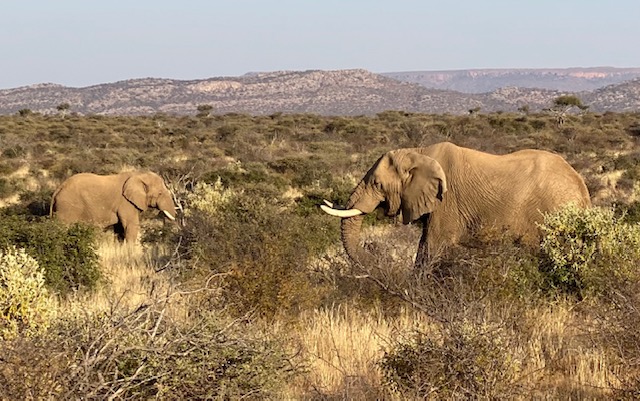The macro-atmospheric phenomenon of amplified climate change has caused significant micro-manifestation challenges in some of the most fragile ecosystems on earth - such as sub-Saharan Africa. One of these manifestations is desertification which impacts humans, flora and fauna all of whom already struggle to survive in these areas. Desertification is a type of land degradation in drylands in which biological productivity is reduced and where fertile areas become arid. Desertification causes the loss of vegetation and food for livestock and humans and the decrease in drinking water reserves due to the loss of aquifers.

Deserts are defined as hyper-arid, arid, or semi-arid with extreme levels of evapotranspiration. Deserts cover about one-fifth of all land on Earth which encompasses about 13% of the world’s human population. Africa’s deserts cover approximately one-third of the land surface including “the Sahara in the north extending over 9 million km2, the Namib ca 135,000 km2, the Kalahari some 260,000 km2, with other smaller desert zones in Kenya, Somalia, Eritrea and Ethiopia and a large desert in neighbouring Arabia.” (Senut, et al., 2009, p. 592).Thus as deserts encroach further in Africa it creates tremendous challenges - and perhaps opportunities for ecotourism - in spite of causing the loss of human lives and livestock and widespread environmental deterioration.
Desertification has been defined as “a series of incremental(sometimes step-wise) changes in biological productivity in arid, semi-arid, and sub humid ecosystems...(and) the creation of desert-like conditions (where perhaps none had existed in the recent past) as the end result of a process of change” (Glantz, M. H., & Orlovsky, N. S.,1983, p. 3). I have been fascinated with deserts since meeting with Dr Lynn Fenstermaker in the Mojave Desert to learn about the many positive attributes of deserts. Her research found that “arid ecosystems, which occupy about 20% of the earth’s terrestrial surface area, have been predicted to be one of the most responsive ecosystem types to elevated atmospheric CO2 and associated global climate change” (Smith, S.D., et al., 2000, p. 79).

The Namib Desert in Namibia consists of “fossil dunes (aeolianites)which are endowed with a diverse fossil fauna including ratite egg shells which form the basis of the first bio chronological scale for the Neogene of Southern Africa” (Senut, et al., 2009, p. 594). The Neogene is a geologic period and system that spans 20.45 million years from the end of the Paleogene Period 23.03 million years ago.“ Correlation of the local and regional paleoclimatic changes at various localities reveals that the history of desertification in Africa (indeed, throughout the world) was intimately linked to global climatic changes” (Senut, et al., 2009, p. 601).
Ecotourism in these unique ecosystems that are impacted by climatic changes provide a meaningful opportunity to enhance the lives of host communities and protect the environment. Recent research with the Namibian Portsmut Farm demonstrates that the harsh realities of desertification is palpable. Nevertheless, Portsmut Farm manager, Janse and his family have learned how to coexist with a changing climate. Desertification has required them to increase grazing from 1 cow to 12 hectares to 1 cow to 20 hectares. 2.2 acres to 1hectare. This farm has sought innovative strategies such as the use of solar energy, and rain water collection and innovative strategies they have protected beautiful African wildlife and they play host to some of the most wonderful farm-to-table meals.

Resources for ecotourism in deserts “include various natural resources which have been made of the mutual effect of topography, climate, water resources and plant type and density. These resources include sun, seasonal wetlands, desert mountains, distinctive tree, desert landscapes, dunes, and caves” (Eshraghi, M., et al, 2010, p. 42). Studies have shown that if “ecotourism is properly managed and planned, it will bring numerous economic resources for the government, private sector, and local groups and societies and could help improve living conditions of people and changing quality of lifestyle in rural environments” (Eshraghi, M., et al, 2010, p. 44).
Careful planning and management of ecotourism activities in arid and semi-arid deserts can play a large role in the education of these ecosystems which could provide additional economic resources and ecological protection. For ecotourists “an environment of scenic beauty and interesting features vegetation wildlife and clean air and water offers many of the resources that attract tourists. Tourism can help justify conservation and in fact, subsidize conservation efforts” (Eshraghi, M., et al, 2010, p. 50) Sustainable desert ecotourism can serve as an important tool to “effectively combat desertification and poverty while helping to transform the secular aspects of desert life, tourism development must be centred on man and the environment”(Eshraghi, M., et al, 2010, p. 50). Thus, with proper ecotourism management and planning it can “bring numerous economic resources for the government, private sector, and local groups and societies and could help improve living conditions of people and changing quality of lifestyle” (Eshraghi, M., et al, 2010, p. 50).

References:
Eshraghi, M., Toriman, M. E., & Ahmad, H. (2010). Sustainable ecotourism in desert areas in Iran: potential and issue. e-BANGI:Jurnal Sains Sosial dan Kemanusiaan, 5(1), 38-51.
Glantz, M. H., & Orlovsky, N. S. (1983). Desertification: A review of the concept. Desertification Control Bulletin, 9, 15-22.
Senut, B., Pickford, M., & Ségalen, L. (2009). Neogene desertification of Africa. Comptes Rendus Geoscience, 341(8-9), 591-602.
Smith, S. D., Huxman, T. E., Zitzer, S. F., Charlet, T. N., Housman,D. C., Coleman, J. S., ... & Nowak, R. S. (2000). Elevated CO2increases productivity and invasive species success in an arid
ecosystem. Nature, 408(6808), 79-82.
DR. TOM MULLIKIN is a senior environmental attorney, author, professor and award-winning documentarian whose environmental and energy law practice has taken him to every continent on earth where he has represented numerous multinational corporate clients and the United Nations (UN). Dr. Mullikin is a professor of practice at the University of South Carolina (Hospitality Retail and Sport Management) where he teaches a course on Ecotourism as well as an Adjunct Professor in the USC School of Law where he teaches a class on Climate Change. In addition he is a research professor at Coastal Carolina University (School of Coastal Environment), and a visiting professor at the Universidad San Francisco de Quito - Galapagos campus. In recognition for his global environmental work, he has been inducted as a Fellow in the Explorers Club (New York) and in the Royal Geographical Society (London) and he has been engaged as a “National Geographic Expert” with the National Geographic Society.


